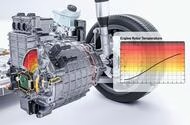Why Does Heat Still Matter in Electric Cars?
You might think that with the shift from traditional gas-powered engines to electric vehicles, heat would be less of a concern. After all, we’re leaving behind all that combustion, right? Not quite. Even though electric cars don’t have exhaust pipes or radiators in the same way, heat is still a big deal under the hood—or, more accurately, under the floor and in the motor.
Here’s why: batteries, motors, and inverters in EVs all handle massive amounts of power. That power inevitably generates heat. Most modern electric cars rely on sophisticated liquid cooling systems to keep things at the right temperature. If any part of the system gets too hot, you risk damaging expensive components or, worse, losing performance right when you need it.
What’s the Big Deal with Rare-Earth Magnets in EV Motors?
Most electric vehicles today use permanent magnet synchronous motors. These motors are prized for their efficiency and power density, but there’s a catch: they rely on rare-earth magnets. These materials—like neodymium and dysprosium—are tough to mine, expensive, and mostly sourced from a handful of countries. The environmental impact of extracting and processing them is significant, and with ongoing geopolitical tensions, supply can be unpredictable.
Some manufacturers are experimenting with magnet-free motors, but for now, rare-earth magnets remain the go-to for high-performance EVs. The challenge? These magnets are sensitive to heat. If they get too hot—specifically, if they reach what’s called the Curie point—they can lose their magnetism. That’s a one-way ticket to reduced performance or even a dead motor.
How Do Automakers Currently Monitor Motor Temperatures?
Here’s where things get interesting. Right now, most EVs don’t directly measure the temperature of the motor’s spinning rotor (where the magnets live). Instead, they estimate it. They use sensors on the stator (the stationary part of the motor) and run those readings through complex algorithms and simulations to guess what’s happening inside the rotor.
But this approach isn’t perfect. Because it’s an estimate, manufacturers have to build in a safety margin—usually around 15 degrees Celsius. That means they have to use extra rare-earth material just to make sure the magnets don’t accidentally overheat and demagnetize. It’s a bit like wearing a heavy winter coat on a chilly day, just in case the temperature drops even further.
What’s New About Continental’s e-Motor Rotor Temperature Sensor?
Enter Continental’s new e-Motor Rotor Temperature Sensor, or eRTS for short. This isn’t just another sensor—it’s the first of its kind to directly measure the temperature inside the spinning rotor of an EV motor. That’s a big leap forward.
Here’s how it works: the eRTS is made up of two parts. The first is a tiny mote sensor embedded right inside the rotor, sitting close to the magnets. The second is a transducer mounted outside the motor casing. The magic happens through piezo ultrasound technology. The mote sensor doesn’t need wires or a battery—it generates its own power wirelessly from the ultrasound waves sent by the transducer. It then sends back precise temperature data the same way.
This direct measurement slashes the margin of error from 15 degrees down to just 3 degrees Celsius. That tighter control means manufacturers can use less rare-earth material, knowing exactly how hot things are getting in real time.
Why Does This Matter for the Environment and EV Supply Chains?
Let’s connect the dots. By reducing the need for rare-earth materials, automakers can make EVs that are both more sustainable and less dependent on volatile supply chains. According to the International Energy Agency, global demand for rare-earth elements in EVs is expected to triple by 2030. Any technology that helps use less of these materials is a win for both the environment and the industry.
Plus, with more accurate temperature data, motors can be pushed closer to their true performance limits without risking damage. That could mean more powerful, efficient, and reliable electric vehicles for everyone.
Are There Any Real-World Examples of This Technology in Action?
While Continental’s eRTS is still a new arrival, it’s already generating buzz among automakers looking to future-proof their EV designs. Imagine a scenario where a carmaker can confidently reduce the amount of rare-earth material in each motor, knowing that the new sensor will keep everything running safely. That’s not just good for the bottom line—it’s a step toward greener, more responsible manufacturing.
What’s Next for EV Motor Technology?
The eRTS is a great example of how small innovations can have outsized impacts. As EVs become more mainstream, expect to see more breakthroughs like this—technologies that quietly make cars better, cleaner, and more affordable.
If you’re following the EV revolution, keep an eye on the details. Sometimes, it’s the tiniest sensors that make the biggest difference. The outcome? Game-changing. And it’s just the beginning.

